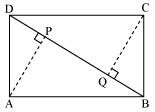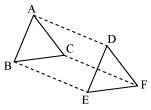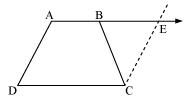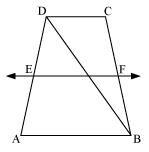Quadrilaterals
The angles of quadrilateral are in the ratio 3: 5: 9: 13.
Find all the angles of the quadrilateral.
Let the common ratio between the angles be x. Therefore, the angles will be 3x, 5x, 9x, and 13x respectively.
As the sum of all interior angles of a quadrilateral is 360º,
∴ 3x + 5x + 9x + 13x = 360º
30x = 360º
x = 12º
Hence, the angles are
3x = 3 × 12 = 36º
5x = 5 × 12 = 60º
9x = 9 × 12 = 108º
13x = 13 × 12 = 156º
Sponsor Area
Some More Questions From Quadrilaterals Chapter
ABCD is a parallelogram and AP and CQ are perpendiculars from vertices A and C on diagonal BD (See the given figure). Show that

(i) ΔAPB ≅ ΔCQD
(ii) AP = CQ
In ΔABC and ΔDEF, AB = DE, AB || DE, BC = EF and BC || EF. Vertices A, B and C are joined to vertices D, E and F respectively (see the given figure). Show that

(i) Quadrilateral ABED is a parallelogram
(ii) Quadrilateral BEFC is a parallelogram
(iii) AD || CF and AD = CF
(iv) Quadrilateral ACFD is a parallelogram
(v) AC = DF
(vi) ΔABC ≅ ΔDEF.
ABCD is a trapezium in which AB || CD and AD = BC (see the given figure). Show that

(i) ∠A = ∠B
(ii) ∠C = ∠D
(iii) ΔABC ≅ ΔBAD
(iv) diagonal AC = diagonal BD
ABCD is a trapezium in which AB || DC, BD is a diagonal and E is the mid – point of AD. A line is drawn through E parallel to AB intersecting BC at F (see the given figure). Show that F is the mid-point of BC.

Mock Test Series
Sponsor Area
NCERT Book Store
NCERT Sample Papers
Sponsor Area